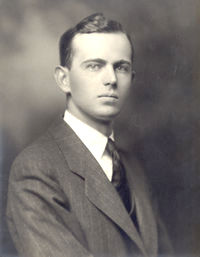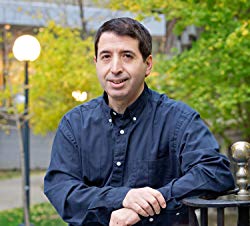The year was 1919, and the man who would transform the face of Canadian broadcasting was just another wide-eyed university freshman. But Edward S. Rogers was no ordinary engineering student. By the time he entered the University of Toronto, he was deeply immersed in the world of electric circuits, vacuum tubes and antennas.
At the age of 11, he was broadcasting in Morse code from one of the nation’s first licensed amateur radios. At 14, he picked up Germany’s declaration of war on a homemade set. Within a few years of leaving university, he would establish a business empire based on his broadcasting skills, and make the Rogers name synonymous with the telecommunications field.
Although he died at just 38, Rogers’ achievements place him firmly in the top tier of Canadian inventors and entrepreneurs. He built the first radio that used AC (“plug-in”) power instead of batteries, revolutionizing the industry. A few years later he founded CFRB (Canada’s First Rogers Batteryless), which was the worlds first all-electric radio station, and is still the country’s largest AM station. He was also granted the first Canadian TV licence in 1931, foreshadowing the dominance in cable television that would be his legacy.
Today his son, Ted Rogers, CEO of Rogers Communications Inc., runs the company with Edward Rogers’ spirit and vision always in mind. Last summer, to honour the memory of his father on the 100th anniversary of his birth, he and his wife, Loretta, gave $25 million to the university. It was at the former department of electrical engineering that his father’s vision first took shape. Appropriately, that department’s modern counterpart has now been named the Edward S. Rogers Sr. Department of Electrical and Computer Engineering.
The gift, at the risk of understatement, is substantial. Its the largest individual donation in the history of the University of Toronto and among the largest individual gifts in the history of Canadian higher education. “It’s an extraordinary contribution from a truly remarkable man,” said Robert Prichard, who concluded his presidency at U of T last June, shortly after the donation was announced.
The sizable contribution wasn’t the first time Rogers has given money to U of T. Three years ago, he donated $2.5 million for the new John W. Graham Library at Trinity College (named in honour of his stepfather). But last year, to mark his father’s birthday, he wanted to do more. “I thought it was time to put in place something of a more substantive, permanent nature,” Rogers says. The gift — and in particular the renaming of the department was the perfect tribute. “It’s a tremendous recognition of the work that my father did, he adds.” In fact, the ties of the Rogers family to U of T have only strengthened since the days of Edward S. Rogers Sr. Not only is Ted Rogers a graduate (BA 1956 Trinity), but his daughter Melinda earned her MBA at the university, giving the family three U of T generations. Edward Sr. attended from 1919 to 1921, but left before graduating to pursue his radio experiments.
Of the $25-million gift, $18 million will go toward undergraduate and graduate scholarships in electrical and computer engineering, enabling the department to more than double its student numbers. Another $3 million will go toward building and equipping the departments new home, the Bahen Centre for Information Technology (on St. George Street, south of Russell Street), due to open in the spring of 2002 (see “Fertile Foundations”). The remaining $4 million will be used to establish two chairs in the department.
Acknowledging the demand for science and technology graduates, the university recently pledged to double its student intake in those areas relative to 1995 levels. (The Ontario Access to Opportunities Program was created to subsidize universities that double their student enrolment in the fields of computer science and electrical engineering.) This will translate into 3,600 undergraduates across nine programs, along with 1,200 graduate students.
Michael Charles, dean of applied science and engineering, says the school was up to the challenge. “The department of electrical and computer engineering is ranked among the very top departments of its kind in North America — certainly the top 10, pushing the top five,” he says. “So not only was Mr. Rogers investing in a department where his father had been a student, he was also investing in a department that has the respect of the world community for what it has achieved in educating students, and in the output of its professors.”
But in a time of tight budgets — and undergraduate tuitions of more than $6,000 — respect and high rankings can go only so far. Getting the most promising students to choose U of T also requires cash. “The competition for top students — locally, nationally, internationally — is intense,” says Charles. “At the undergraduate level, our students have seen their fees rise significantly in recent years. One of our priorities, therefore, is to provide merit-based scholarship awards, and also awards based on financial need, to as many students as possible.”
The Bahen Centre, meanwhile, is poised to be the university’s information-technology showpiece. Besides housing the Edward S. Rogers Sr. department of electrical and computer engineering, the eight-storey, 366,000-square-foot building will also accommodate the department of computer science, the Jeffrey Skoll BASc/MBA program, the Professional Experience Year program and part of the mechanical and industrial engineering department. It will also be the home of the Rogers AT&T Wireless Communications Laboratories, designed to be a leader in wireless technology research. In all, the centre will house more than 50 laboratories, including state-of-the-art signal processing and digital media labs, and smart classrooms with computer access.
While nearly a century has passed since Edward Rogers wired up electrical circuits in a University of Toronto laboratory, the communications revolution that he helped start has not ended. In fact, one could argue that a second wave of that revolution — perhaps even more far-reaching than the first — is under way right now, as television, computers, the Internet and satellite technology converge in new and unpredictable ways. “That’s why the gift is so right,” said Prichard. “The very kind of vision that Edward Rogers Sr. had, which spawned a revolution in communications, is being replicated now.”
Recent Posts
U of T’s 197th Birthday Quiz
Test your knowledge of all things U of T in honour of the university’s 197th anniversary on March 15!
Are Cold Plunges Good for You?
Research suggests they are, in three ways
Work Has Changed. So Have the Qualities of Good Leadership
Rapid shifts in everything from technology to employee expectations are pressuring leaders to constantly adapt






